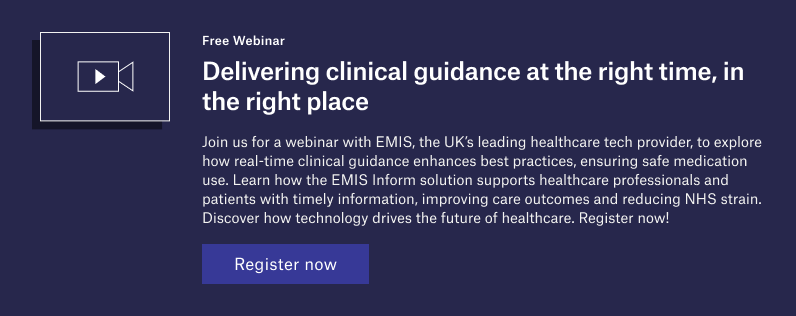
Medication adherence is one of the most persistent challenges in healthcare today. Despite medical advances and the increasing availability of treatments, many patients struggle to consistently take their medications as prescribed. This problem contributes to poor health outcomes, disease progression, and increased healthcare costs. But can direct-to-patient communication from pharmaceutical companies provide a solution to this issue? EMIS, a leader in healthcare technology, believes it can. By leveraging its Patient platform where over 9m users have linked access to data from their GP record, EMIS is transforming how patients engage with their medication regimens, ultimately aiming to improve adherence and patient outcomes.

The medication adherence crisis
For chronic conditions such as diabetes, cardiovascular diseases, and respiratory conditions, the consistent use of prescribed medications is often the cornerstone of effective disease management. Yet, studies show that nearly half of all patients fail to adhere to their prescribed medication regimens [1]. This poor adherence not only exacerbates the progression of diseases but also leads to higher rates of hospitalisation and increased mortality. For healthcare providers, non-adherence translates into greater demand for services, operational inefficiencies, and higher costs. [2]
Non-adherence is particularly common in diseases such as chronic obstructive pulmonary disease, with only 33% of patients in the UK continuing to take their medication after ten weeks. For patients taking medication for schizophrenia, the figure is 52%, while for asthma it is 67%, and for diabetes it is 78%. The economic impact is also substantial. Non-adherence (for asthma, type 2 diabetes, high cholesterol/coronary heart disease, hypertension and schizophrenia alone) is estimated to cost the NHS more than £930 million per year. [3]
Several factors contribute to medication non-adherence. Personal beliefs and cultural attitudes play a significant role, with some patients avoiding medications due to scepticism about their necessity or efficacy. Social media has also become a powerful influence, often spreading misinformation that can lead patients to distrust conventional medicine. Practical barriers, such as lack of access to healthcare services and poor communication between patients and providers, further complicate adherence. Additionally, side effects, complex medication regimens, and simple forgetfulness often result in patients missing doses or discontinuing treatment altogether.
The power of direct-to-patient communication
EMIS aims to tackle these challenges by utilising direct-to-patient communication through its Patient platform, which includes the widely used Patient Access app. With more than 17.2 million registered users and eight million page views per month, EMIS has created a platform that is already a trusted resource for patients. By integrating pharmaceutical companies into this ecosystem through its Inform solution, EMIS enables the delivery of timely, relevant, and personalised information directly to patients. As part of its ethical principles, EMIS will only ever work with companies that have a proven dedication to improving clinical safety and patient outcomes by sharing information aligned with National Institute for Health and Care Excellence (NICE) guidance. This approach empowers patients to take control of their own health by providing them with the knowledge they need to adhere to their medication regimens and manage their conditions more effectively.
The Patient Access app offers features such as the Medication Assistant, which provides tailored information to patients based on their current medications and medical conditions. By linking the app to their GP practice, patients can receive personalised content based on information within their electronic health records (EHRs). This includes reminders about when and how to take their medications, what side effects to expect, and how to manage those side effects. For patients overwhelmed by the information provided during clinical visits, having this resource available on their own time can significantly improve their understanding and adherence.
Moreover, the Patient platform is not limited to medication reminders. It also offers a wealth of resources to support lifestyle changes, which are often necessary for optimal health management. From symptom checkers to healthy living articles and educational videos, the platform provides comprehensive tools to help patients maintain their health. These resources are particularly valuable for patients with chronic conditions who need ongoing support beyond their medication.
Real-world impact
The effectiveness of EMIS’s direct-to-patient communication strategy is evident in its successful campaigns. One notable example comes from a campaign to raise awareness about hormone replacement therapy (HRT) for menopause. Through the Medication Assistant functionality, EMIS delivered monthly articles to patients who had been prescribed HRT. The results were impressive: more than 100,000 emails were opened within the first month, reflecting a 71% engagement rate. Over the course of a year, the campaign maintained an average open rate of 57%, demonstrating sustained interest and engagement from patients.
A campaign focused on patients taking metformin for Type 2 Diabetes provides a further example. Over six months, EMIS delivered weekly information on diabetes management, achieving a 71% open rate for the first article and an average open rate of 61% for the entire campaign. These high engagement rates highlight the potential of direct-to-patient communication to significantly improve medication adherence and patient outcomes.
Benefits for healthcare providers and the industry
For healthcare providers, improved medication adherence through direct-to-patient communication offers numerous benefits. Firstly, it enhances the effectiveness of treatments, leading to better health outcomes for patients. This translates to faster recovery times, fewer complications, and a reduction in the severity of chronic conditions. As a result, healthcare providers can expect a decrease in hospital admissions and readmissions, which is particularly important for managing chronic diseases such as asthma, COPD, and heart disease.
Operational efficiency also improves when patients adhere to their medications. Fewer appointments, reduced hospitalisations, and lower healthcare costs are just a few of the benefits. Additionally, by fostering a more engaged and informed patient population, healthcare providers can build stronger relationships with their patients, which in turn increases trust and compliance with treatment plans. This trust not only improves patient outcomes but also enhances the reputation of healthcare providers.
For pharmaceutical companies, collaborating with health tech providers like EMIS to provide direct-to-patient communication can bolster their brand reputation. When patients receive accurate, timely information about their medications, they are more likely to adhere to their treatment plans, leading to outcomes that align with the expectations set during clinical trials. Moreover, by collecting data on patient adherence and outcomes, pharmaceutical companies can refine their products and communication strategies, further improving the effectiveness of their treatments.
The future of medical adherence
By providing patients with the information and support they need to manage their health effectively, EMIS is helping to reduce the burden of non-adherence, improve health outcomes, and enhance the efficiency of healthcare systems.
As healthcare continues to evolve, the importance of engaging patients directly will only grow. EMIS’s approach offers a compelling model for how technology can bridge the gap between patients and the care they need, ultimately leading to better health for all. Download the whitepaper below to find out more.
References:
- https://www.ncbi.nlm.nih.gov/pmc/articles/PMC3068890/
- https://www.ncbi.nlm.nih.gov/pmc/articles/PMC3934668/
- https://link.springer.com/article/10.1007/s40273-017-0554-9




